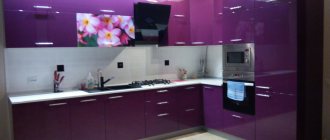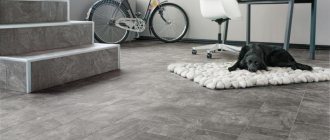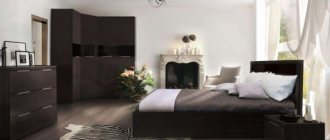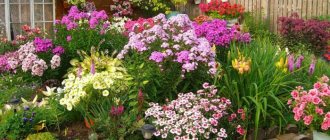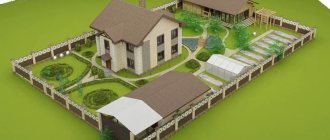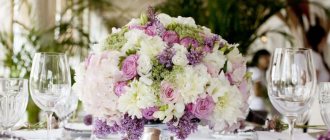Coniferous plants are often indispensable for landscape design. An easy-to-maintain green garden decoration will look great all year round and purify the air. Compositions from coniferous plants are easy to combine with other elements; you can add shrubs, stones and even flowers.
Despite the fact that in nature we have only a few species of conifers, due to introduced species, and even more due to the selection of ornamental varieties, the market offers a choice of hundreds of plants that are resistant to our climate. Therefore, everyone, if desired, can create a corner of harmony on their site to their own taste.
Secrets of creating perfect compositions
Conifers in the landscape design of small areas are often chosen among dwarf varieties. Small plants are compact and do not clutter up the area, but they grow more slowly and therefore may command higher prices. Before buying plants, it is better to draw up a sketch in advance or order a project from us, calculate the required number of plants of each variety, taking into account the available area and the size of adult plants, prepare places for planting, and only then go to the garden center or nursery.
During landscape design, do not forget about the spatial composition; try to make sure that all the elements of coniferous and deciduous plants are combined in size and shape, and do not contradict the surrounding space. It is always easier, cheaper and better to follow existing natural conditions than to try to radically change them. If the neighboring forest grows mainly pine trees, then on your site, most likely, there will also be suitable conditions for them.
Not the last place when drawing up a plan should be occupied by the color scheme - many conifers used in landscape design differ significantly in tone. The palette is varied - there are plants of pale light green, rich green, yellow, blue and other colors. At the same time, the color of the plant changes with the season. Young growths usually look the brightest. If you are thinking over a composition that will include three elements, use no more than two colors. The maximum for a composition of five elements is three colors. In the case of large-scale projects using different breeds over large areas, it is better to separate groups by color to avoid disharmonious combinations.
Harmonious color combination
Much depends on your goals. If the task is simply to decorate the area and try your hand at a new business, then it is better to start with a small project - for example, a flower bed or an alpine slide. Many gardeners choose coniferous trees to create a hedge to separate the area from the neighboring area, extraneous sounds and dust. This way you can zone the space - for example, fence off a utility area or create a garden room. To replace the classic yew hedge, they use common spruce - a very popular option in Scandinavia and Finland, less often other types of spruce - Serbian, prickly. Western thuja hedges are very popular. It grows quickly and lends itself well to molding. Less commonly, hedges are grown from pine trees or junipers.
Coniferous hedge. Serbian spruce, then larch. In the foreground is the mountain pine “Pumilio”.
Creating a landscape design from coniferous plants with your own hands is a difficult but exciting task for beginners. Therefore, if you decide to try, then first study as much material as possible on this topic. Pay attention to one common mistake when conifers are called conifers. Conifers can probably be used in landscape design; but we would not recommend doing this, since growing conifers may fall under an article of the criminal code. Ephedra is a foliage narcotic plant. Don't confuse it with spruce ;)
Practical tips for creating a coniferous garden at your dacha
You don’t have to wait until the warm summer to enjoy pleasant colors in your dacha. A site can delight the eye with beauty and well-groomed conditions at any time of the year if evergreen coniferous plants are planted on it. They will highlight the colors of summer flowers and autumn foliage, protect from the wind in winter and will look great dusted with snow. In addition, coniferous plants emit phytoncides that purify the air. There are hundreds of varieties of evergreens. While many of them grow into massive specimens, there is still a huge selection of dwarf conifers to choose from. We have prepared for you 12 practical tips for planting coniferous plants in your summer cottage.
Create an elegant frame for your flower garden
The rounded shapes of coniferous plants are perfect for framing a flower garden. According to psychologists, spherical shapes have a calming effect on the nervous system.
The dwarf Norway spruce Nidiformis (Picea abies) has a cushion shape with a central depression and looks like a nest. It is ideal for borders of flower beds, rock gardens or alpine gardens.
“Drape” the foundation of the house
Because low-growing evergreens retain color all year, they are great for planting around the foundation of a home.
Tip: Try combining plants of different shapes and colors, but plant them compactly so that they do not grow too wide. Weymouth white pine and Montgomery spruce are just a few of the possible options.
Green screen from prying eyes
Most often, evergreens are used for screening from prying eyes. Tall, columnar varieties of western arborvitae, yew and juniper are great for small spaces.
Create a picturesque backdrop for flower beds and paths
Give flowerbeds and paths a beautiful backdrop by planting conifers. Choose tall trees with dark foliage to highlight the vibrant flowers at the base. Or add unusual colors (like blue pine) to add interest to the plant color scheme.
Tip: pay attention to the shapes of the plants. For example, tall upright pines and Medora junipers contrast beautifully with perennial flowers and grasses.
Create a "garden room"
Choose a spot on your property and plant 4 medium-sized conifers, such as silver spruce (Picea canadensis cv. conic), forming a square. Even if you don’t plant shrubs that form the “walls” of the room on the sides of the square, you will still get a cozy corner that will delight you all year round.
Cover bare soil
“Lay out” a beautiful carpet on your site where the ground is unsightly bare and rocks protrude. The spiky silver-blue beauty of the spread-branched spruce (Picea pungens 'Procumbens') or juniper will do the job wonderfully.
Add artistry to the area
Make the flower bed under the window more interesting. Yew, boxwood and juniper respond well to tight pruning. Take advantage of this and give them interesting shapes, such as spirals.
Add solemnity to the entrance to the site
Artistically trimmed evergreens (like the juniper in this photo) can be planted at the gate, giving the entrance a more formal appearance. Trees will have to be trimmed every year, but it’s a joyful job and the effect is amazing.
Enhance the colors of autumn
By mixing trees that lose their leaves in the fall with evergreens, it's like putting the colors of fall in a frame. Engelmann spruce, Korean fir and blue spruce look delightful next to the vibrant fall foliage.
Coniferous plants in tubs
Large, colorful conifers, such as Austrian pine, will add color and provide protection from prying eyes if you plant them in pots on your balcony or veranda.
Protect your home from the wind
Don't let cold winds blow past your windows. Plant coniferous trees on the north side of the site and where the wind most often blows in winter. You will have to pay less for heating your home!
Stop mowing grass on awkward slopes!
Plant a juniper called “Blue Carpet” on the slopes. It will maintain a nice color all year round and will stop erosion and most weeds.
Alpine slide
The Alpine slide is created according to the same principle - creating an imitation of the wild nature of the Alpine belt. Keeping the previous principle in mind, you can combine coniferous compositions in landscape design with other plants and stones. It is important not to fall into typical mistakes described in English literature of the 19th century, and not inadvertently make a “dog’s grave” or “raisin bun”.
Miniature alpine slide - rock garden in a stone trough (miniature rolling pin)
Try choosing a cascading structure to add a special charm to the area. It is important to arrange the parts so that large elements do not block smaller ones.
Compositions with coniferous plants in the landscape design of a summer cottage
Coniferous trees create great opportunities for garden design; many gardeners willingly use them on their plots. At the same time, to create a unique atmosphere, it is not necessary to choose many varieties at once. The main condition is the correct combination of size, color and shape. Even a combination of several shrubs can give the garden its own unique charm.
Simple conifer design
If the area is small, this is not a reason to abandon conifers. Even a simple design based on these plants will perfectly organize the space and create a kind of center of attraction in the country house. Here are some ideas for creating such a design:
- The most obvious option is group planting of coniferous trees. In this case, you can choose plants of the same height or different ones. It is important that they differ in color: for example, dark green and blue spruce will look great due to the contrast.
- If the choice fell on fairly large trees, it is better to plant them in the most remote places of the garden. Medium-sized shrubs can be placed in corners, along the natural boundaries of different zones.
- If there are special corners in your dacha that are unique business cards, you can decorate them with conifers. For example, plant a thuja along the banks of a country pond or create a recreation area with shrubs.
NOTE
When combining different types of coniferous trees and shrubs, it is important to take into account their growing conditions. For example, light-loving thuja should not be placed in the shade of large trees.
Pines in the garden (video)
Thuja and juniper in landscape design
Small coniferous plants, such as thuja and juniper, have long been common in the landscape design of garden plots. The reason is not only its decorative potential, but also its rather unpretentious lifestyle. Here are a few ideas with which you can successfully fit these shrubs into almost any garden:
- First of all, these plants make it possible to perfectly decorate country paths, as well as living areas. For example, if you place several pots around the perimeter of a country house, this will perfectly organize the space and separate the building from the garden.
- Since juniper covers the soil well, it can be used in almost all areas of the garden that for some reason are not developed.
- You can also use it to create a magnificent hedge. If you plant it in one row at short intervals, you will get a magnificent green wall that can beautifully separate one area of the garden from another and also creates the effect of a small forest.
Selection of plants for a coniferous composition
When you see a coniferous garden in a photo, it seems that creating your own composition will not be difficult, but the first problems arise almost immediately - when choosing plants.
Choosing conifers is not an easy task
In a small garden, you should not use seedlings of wild spruce and pine trees - it will be difficult to keep them compact, and they will quickly reach their characteristic height and diameter, taking up almost the entire space on the site.
Choose compact plants that have been specifically bred for landscape design, because their growth is not as active and will not negatively affect the composition in the future. This will require special literature and catalogs published by large nurseries or industry associations. The most complete catalog in Russia is published by the Association of Planting Material Producers of Russia, APPM.
Choosing the right plants is the key to success
All conifers can be divided into three groups depending on size:
- Tall growing . This group includes prickly spruce, which can reach 40 meters in height, Serbian spruce with a narrow crown, prickly spruce, including the blue form, Scots pine, Siberian pine (cedar), and pseudohemlock.
- Medium growing . Western thuja and its varieties “Brabant”, “Smaragd” and others, Scots pine “Norske Type”, mountain pine, columnar juniper, some varieties of prickly spruce.
- Undersized . An array of mountain pine “Pumilio”, common spruce “Nidiformis” (nest-shaped form), common juniper “Repanda” (creeping form pressed to the ground), horizontal juniper, microbiota (“Russian cypress” native to the Far East) can look impressive on the site. .
Juniper and conifers
Planting juniper next to other conifers is a very common practice. The main thing here is to choose the components: the quantity can be arbitrary, the only mandatory condition is the contrast of the colors of the needles and the height levels of the shrubs. When forming a flower bed or garden plot in a cascade, the cone-shaped tall subspecies of juniper bushes are planted first, and then, in descending order, medium-sized and low-growing ones.
It is also possible to combine several species of juniperus, provided the soil type is suitable (if the species like different acidity of the soil, it will be quite difficult to maintain the composition in a viable state).
Did you know? To visually enlarge a site, designers often use dwarf trees and low-growing shrubs. This effect is called the "Alice in Wonderland" effect.
Conventionally, all types of layout are divided into:
- landscape (all elements are arranged in a chaotic order - flowers, bushes, trees);
- symmetrical (two or more types of fir trees with the same number of juniper bushes);
- for zoning (example: spruce, thuja, juniper).
Subtleties of planting and care
Before planting a tree or shrub, consider that it will need more space in the future, so leave room to spare based on the size of the mature plant. If the diameter of an adult shrub is, for example, three meters, then this is the minimum area that must be allocated for this variety . Several smaller seedlings can be planted in this area, which will quickly close their crowns and cover the ground.
It is important to leave enough space for conifers to grow. The planting density and size of the clumps is determined both by the dimensions of adult plants and the size of seedlings.
Most species require minimal care - systematic watering in the initial period and during drought, weeding, the soil must be loosened and fertilized in a timely manner. You can pinch young shoots to form a crown.
Follow simple but important rules:
- Under no circumstances should the root collar be allowed to go deep. It is necessary to check whether it is buried during the packaging of the plant in the nursery. You need to find the main, skeletal thick roots. The top of the roots extending from the trunk, like the spokes of a wheel, should be located at the level of the top of the soil.
- Mulch the plantings with crushed bark, wood chips or pine needles 4–5 cm thick, without covering the root collar.
- When you combine tall and short plants, achieving harmony can be difficult. To avoid a feeling of clutter, do not choose plants of many types and colors. It is better to use one or two species, or varieties, but in large quantities, than to plant the entire range of the garden center on the site.
- Try playing with geometry by combining different shapes - for example, spherical and pyramidal plants.
The ideal time for planting is spring after the soil has thawed or from late summer to early autumn. In mid-summer you can plant conifers on the site, but it is better to avoid hot periods. It is better to mark planting sites in advance using pebbles or pegs. In this case, it is important to prepare the planting holes and soil - mix the soil with peat and sand. The recipe for the soil mixture depends on the available soil; you can dilute it with sand and peat.
Most conifers prefer well-drained soils, so in areas with heavy, clayey soils you will have to make large planting holes with lighter soil and lay drainage for the bases of the planting holes and pit, leading it into a drainage system or ditch.
Look at the trees growing naturally on and near your property. If these are pine trees, then the soils are most often sandy and light; Spruce trees tolerate dry soil less well.
Newly planted dwarf cedar (Pine pine) and Scots pine (in the background).
When planting a plant with a clod of soil in burlap and netting, after placing the seedling in place in the hole, cut the top of the netting and untie the burlap, find the main roots and make sure that the root collar is not buried. After this, remove the mesh from the top of the ball, fill it with soil around the ball, and spill it with water. Add soil again and compact it with your foot.
When planting a plant from a container, also make sure that the root collar is not buried and that the roots are not curled. If necessary, remove the soil to the level of the root collar, and all small roots that may have grown around the trunk above the main roots. Roots tightly twisted along the walls of the container are a defect; it is better not to take such plants; but cut the top layer with a sharp knife in four to five places, vertically.
After planting, it is better to mulch the tree trunk or the entire clump (chopped bark, wood chips, cones or pine needles are used as mulch, depending on what is available and what is convenient to use). Mulch helps retain moisture, maintain soil life, and discourage weed growth. The thickness of the mulch should be sufficient, at least four centimeters. After planting, water the plants regularly, especially in hot weather. However, you should not overwater them, especially in heavy soil. Roots, first of all, require oxygen, and they should not be allowed to soak for long periods of time. The plant may die.
There is an excellent signal that will help you understand that thujas, ornamental spruces and junipers feel great in a new area - this is the appearance of new growths. Coniferous plants grow actively in central Russia and the North-West in late spring - early summer, then the growth of shoots stops. The second wave of growth, much weaker, occurs in August. Plants need to be planted so that they do not interfere with each other.
Preparatory work
If you decide to create a rock garden yourself from conifers and flowers, work begins with planning the site. It is important to choose the right stones and vegetation, and carefully consider the design.
Layout and diagram of a coniferous rock garden
The first step is to give a clear definition of rockery in order to know what is to be created. The building is a separate area with green spaces and stones. It is often located on the slope or top of a small hill. The occupied area ranges from 3 to 15 m2. Any type of composition is created to be viewed from a close distance. There are three main schemes for rock gardens with coniferous plants, each of which is arranged according to its own rules.
The first scheme is called stable. It is created according to the following rules:
- Single stones are considered basic. Large sizes are acceptable for them. Small stones are grouped in rockeries with conifers.
- Varieties of ground cover plants are arranged in groups. Each green area is fenced with stones that prevent vegetation from spreading throughout the composition.
- Conifers are planted as slow-growing ones that tolerate pruning well.
- Conifers can be supplemented with ordinary shrubs, but low-growing ones. Dwarf barberries and cinquefoil are well suited.
- It is unacceptable to use plants that quickly reproduce by seeds or produce root shoots. When the conifers grow, they are cut up to 4 times per season. In times of drought, watering becomes more frequent.
- If the rockery has acquired strict outlines, to smooth the transition, ground cover plants are allowed to grow to the side outside the composition.
The stable scheme has one significant disadvantage. Rockery gets boring over time.
The second scheme is called a changing landscape. It is created according to the following rules:
- The composition is based on about five large conifers.
They form an island effect. In the future, other shrubs can be planted next to the conifers. Advice! The advantage of the changing landscape scheme is freedom of action. Planted trees and shrubs can distort the composition, but it will not lose its attractiveness. - The areas where plants are supposed to be planted are temporarily covered with gravel and planted with non-valuable plant varieties and annuals.
- The appearance and size of the stones do not play a special role. However, a rockery will look more beautiful with attractive boulders.
- Conifers and other plantings are planted so that, if necessary, they can be dug up for replanting or replacing with other varieties.
The scheme is great for people who have no experience creating rockeries. However, the landscaped area does not create the effect of an island of untouched nature with moss-covered stones.
The third scheme is called temporary. They create it by adhering to the following rules:
- In order to get a chic composition of expensive conifers in the future, the area is planted with small seedlings. The planting scheme is thought out in advance, taking into account the growth of plantings. Knowing their adult size, the optimal distance between conifer seedlings is calculated.
- According to a temporary scheme, a rock garden is created on a slope with conifers, but the rise should be small. It's better if it's not there.
- Small stones and gravel-filled areas in the rock garden are temporary. In the future, to update the composition, they will be replaced with large boulders.
- The front area is decorated with plantings of cherry blossoms. Ground cover plants growing in the depths of the island must be replanted over time. The growing conifers will cover them.
When all the main conifers in the temporary rock garden have grown, it is no longer possible to change the picture. We'll have to look for a new area to create the composition.
Choosing a location for a rock garden
You can place a rock garden on any free area of the yard. However, the best place is considered to be a lighted corner with a good view. If there is a choice, a rocky garden with conifers is located in the southeast or southwest of the common area. Small compositions with an area of 3.5 m2 fit harmoniously into the landscape of a private courtyard. They are located near a gazebo, an artificial pond, in the center of the garden, where there is a resting place.
Selection of stones for rock gardens
Conifers combine beautifully with stones of igneous origin and rounded rocks. Granular and layered boulders look impressive. Preference is given to marble, dolomite, gabbro. Of the simpler, more readily available stones, sandstone is suitable. Of the small fractions used for scree, pebbles, gravel, and perlite are used.
Many designers prefer to use only one type of stone. Instances are selected in different sizes. They don’t take any stone, but choose one with a bizarre, interesting shape and a pronounced relief.
Photos and names of conifers for rockeries
Conifers grown in a nursery are considered the best for rockeries. Seedlings are purchased with a closed root system. The general characteristics of most conifers are light-loving, frost-resistant, and adaptable to any type of soil. If the rockery is located in the shade, then coniferous crops will take root here too.
The main requirement is dwarfism of plants. Depending on the design of the rockery, medium-sized conifers can be used. Trees, shrubs and ground cover plants are used for planting.
In the background, medium-sized conifers are always planted, which will rise above other plantings. This list includes Australian pine, columnar thuja. Weeping larch, as well as pyramidal juniper, look impressive. The queen of the rock garden is the Serbian spruce.
Small plants are planted near large boulders. Canadian spruce, mountain pine, and Cossack juniper are popular. The variety chosen from thujas is Smaragd. Berry yew and Lawson cypress grow well.
The areas between the stones are planted with conifers spreading over the ground. Prominent representatives are Canadian hemlock and scaly juniper. In combination with conifers, free areas are planted with ground cover flowers, for example, felted flower.
Conifers in rockeries are used with any shade of needles. Refuse varieties with yellowness. Among the green mass, such plants seem withered or diseased.
Pine
Gardeners often choose pine trees for their unpretentiousness to climate and soil.
Pine seedlings
Pine seedlings in the nursery
Pines in the landscape design of the fourth and fifth climatic zones, which corresponds to the most populated territory of the middle zone and north-west, are used as follows: Scots pine, Scots pine “Norske Type”;
Surprising as it may seem, some varieties of very winter-hardy Scots pine growing in the Arctic Circle are not winter-hardy enough in St. Petersburg, including the “Votereri” variety.
- Mountain pine and its many forms and varieties (Pumilio, Mugus, Winter Gold, Pug and others);
- Rumelian pine (Balkan) with very long needles and large cones;
- European and Siberian pine;
- Korean pine, with very large edible nuts;
- dwarf pine (dwarf pine), reminiscent of mountain pine, but with edible pine nuts and bluer needles.
- The once popular Weymouth pines are highly susceptible to attack by rust fungi and are almost out of use.
Pine bonsai against the background of a coniferous hedge
Spruce
This tree, typical of the middle zone, also does not require serious care. In landscape design, common spruce, Serbian spruce, and prickly spruce, which has a green and blue shape, and many decorative varieties are used. For large compositions, tall trees are used.
The blue spruce on the site is not necessarily the blue form of the prickly spruce. In Serbian spruce, due to the color of the underside of the needles, the overall color is also slightly blue.
Spruce on the site. Simple topiary made from Norway spruce
Other spruces are also used:
- Dwarf variety of Serbian spruce “Nana”;
- A spherical variety of prickly spruce with blue needles “Glauca globoza”;
- A narrow-clone variety of common spruce with weeping branches “Inverse”.
Advantages of conifers
Planting evergreens on a site provides great advantages over other plants.
- Aesthetics. Conifers retain their decorative appearance throughout the year, regardless of weather conditions.
- Diversity. Numerous varieties will help you create living compositions of different shapes and colors.
- Unpretentiousness. Such green spaces do not require constant maintenance. They grow in all types of soil and do not require a lot of sunlight or regular watering, so any area of the yard is suitable for planting.
- Environmentally friendly. Conifers secrete essential oils, enriching the surrounding air with the rich scent of the forest.
Thuja occidentalis
These trees, originally from the west coast of the United States, have long been naturalized in Europe, easily adapt to different conditions, and are not afraid of frost and city air. Easy care and a wide variety of crown shapes make them desirable guests in summer cottages.
Thuja occidentalis on the site
Plants easily fit into different compositions. Thuja makes dense hedges.
Yew hedge. Sissinghurst, UK
Hedges are great for defining green rooms in an area. This hedge of thuja occidentalis 'Brabant' separates the economic area with a vegetable garden from the residential part of the site
Juniper
A wide selection of junipers - although there are only a few species suitable for climate zones 4 and 5, they have developed varieties of different sizes and shapes, ranging from trees up to ten meters high, to creeping shrubs with a diameter of several meters, but a height of centimeters.
Juniper. Botanical Garden in Brno
Juniper has gray cones that are used to make gin.
Yew
The yew is the only native conifer in the UK and is associated with perfectly trimmed hedges and free-standing dark conifers. Unfortunately, winter-hardy yew species are very difficult to find, and most yews from Europe do not winter well in our country .
Yew berry, hedge at Sissinghurst


